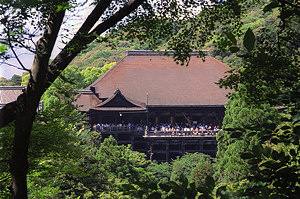Kyoto Travel Guide
When to go
The best time to visit Kyoto is during the cherry blossom (sakura)
or Autumn leaves (momiji) season because the weather tends to be cool
and sunny, the temple treasures are on display and museums have special
exhibitions. As a general guide, cherry blossom lasts for about a week
and could come any time from the first to the third week of April.
Autumn leaves turn red from the second week of November through to the
beginning of December. However, hotels
and guest houses are usually
booked up three months in advance for these periods, especially single
rooms in cheaper hotels or guest houses.
Kyoto City

Kiyomizudera Temple is a popular
temple in the eastern part of Kyoto known as Higashiyama. Its
spectacular view attracts many overseas and Japanese tourists.
Main attractions: Large open veranda with a magnificent view of
Kyoto. Cherry blossom in April and red maple leaves in November, with
the hillside lit up in the evening at both times. One of the Saigoku
Kannon pilgrimage temples. Mentioned in The Tale of Genji
and other ancient literature.
Founded: 780.
Principal image: Kannon. Not on display.
Getting there: 25 minute walk from Keihan-Gojo Station.
Sanjusangendo Temple is a
popular temple in the eastern part of Kyoto known as Higashiyama.
Main attractions: 1,001 figures of Kannon carved in the 12th and
13th centuries.
Founded: 1164.
Principal image: Kannon.
Getting there: 10 minute walk from Keihan-Shichijo Station.
Opposite Kyoto National Museum.
Toji Temple was founded to protect Kyoto
in 794.
Main attractions: Tallest pagoda in Japan (1643).
Founded: 794.
Principal image: Momoyama period Yakushi trinity.
Getting there: 5 minute walk west from Kintetsu Toji Station.
Heian Jingu Shrine is a 19th
century replica of the Heian-era Imperial Palace.
Main attractions: Extensive Heian-style gardens with cherry
blossom, irises and water lilies. Evening concerts beside the lake
during cherry-blossom week in April.
Founded: 1895.
Deities: Emperor Kammu and Emperor Komei are enshrined here.
Getting there: 10 minute walk north from Higashiyama Sanjo
subway station on the Tozai Line .
Kinkakuji Temple. Built in 1397
a retirement villa for Shogun Ashikaga Yoshimitsu, Kinkaku-ji was
converted into a Rinzai Zen temple after Yoshimitsu's death. The
main hall was burnt to the ground by a deranged monk in 1950 and
rebuilt five years later, an incident that provided inspiration
for Yukio Mishima's novel, The Temple of the Golden Pavilion.
Main attractions: The upper floors of the pavilion are
covered with gold leaf.
Founded: 1397.
Getting there: From Kyoto Station take bus 12, 59, 204, or 205
and get off at the Kinkakuji-machi stop.
Daikaku-ji Temple is a very
picturesque temple beside a large pond in western Kyoto.
Main attractions: Cherry blossom and three-day Harvest Moon Festival.
Founded: 9th century.
Principal image: N/A.
Getting there: About 50 minutes by Kyoto City Bus 28 from Kyoto
station.
Kyoto National
Museum is the most impressive museum in Kyoto.
Main attractions: A good permanent collection of Buddhist art
and interesting special exhibitions. April 24 - May 27, 2007
Fujiwara no Michinaga: Courtly Splendor and Pure Land Faith.
Admission: 500 yen.
Hours: 9.30-5.00. Closed Mondays.
Getting there: 10 minute walk from Keihan-Shichijo Station.
Kyoto Prefecture
Ishiyama-dera Temple is a
beautiful mountain temple beside Lake
Biwa.
It the 13th stop on the Saigoku Kannon
Pilgrimage and is well known for its association with Tale of
Genji and its author Murasaki Shikibu.
Main attractions: Cherry
blossom in Spring, irises and wisteria in May, extensive
grounds and garden, hondo with veranda and seats inside.
Founded: 749.
Principal image: Nyorin Kannon.
Getting there: Train from Keihan-Sanjo station,
changing at Hama-Otsu for Ishiyamadera at the end of
the Sakamoto local line. Walk 10 minutes beside the river.
Jingo-ji Temple is a very
picturesque temple overlooking a river valley west of Kyoto. It was
originally an important centre of esoteric Buddhism and one of the
three most important temples in the Shingon sect. It is only 10
minutes' walk from Saimyo-ji and Kozan-ji temples and lies at one end of the
Kiyotaki-no-Michi path.
Main attractions: Autumn foliage in November, carving of
Yakushi Nyorai, temple treasures of esoteric Buddhism on display May
1-5, throwing clay
disks off the cliff for luck.
Founded: 781.
Principal image: Yakushi Nyorai.
Getting there: About an hour by City Bus from Kyoto
station to Takeo, and a 15-minute climb to the temple.
Kurama is the site of an
annual fire festival north of Kyoto.
Main attractions: Kurama-no-Hi Matsuri Fire
Festival on October 22 beneath Yuki-jinja shrine. Pilgrimage path
from Kibune to Kurama-dera Temple.
Getting there: 30 minutes by train from Demachi-Yanagi
Station to Kurama Station. Or get off at Kibune station and
walk over the old pilgrim's path.